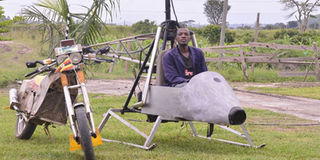Nkaheza’s aircraft story not about to end

Nkaheza has made a chopper and a motorbike. Courtesy photo
What you need to know:
According to Justus Niwagaba, the projects director, they are working on two issues key among them resetting the engine and adjusting the propellers to allow the chopper fly and land when it need to.
They are also working on a way through which they can make the chopper lighter to allow it fly freely.
Joseph Nkaheza, 29, stands about 5.5 feet tall. He is relatively dark with some scars on both hands and a part of his face.
These [scars] are a reminder of his failed attempt at making a plane that can fly and land safely.
“I broke both hands when I attempted to land. I had flown the plane for about 10 minutes. But it failed to land. I did not know what to do. I just switched off the engine and it came tumbling,” he says, as he stretches out his arms to reveal the gross scars around the knuckle area.
Nkaheza speaks softly with a calculated approach to every question, exuding a rare form of brilliance for a Primary Seven drop out.
His is a story of a self-taught man who through his craftsmanship has written a new chapter as the only Ugandan who has attempted to assemble a flying chopper.
At only 17 years, Nkaheza was already out of school and without parents to push him through the trials of life; he had to think of an option.
“When I saw that I was not doing well in class, I opted out and started seeking jobs to till people’s land. It was a hard life because around the same time I had lost my parents,” a resident of Rwampara in Mbarara District says as he narrates how for a long time he would survive off odd jobs such as washing and repairing cars, electronic appliances and other types of machines.
“I did not have to go to school to do all these things. I visited garages and observed as other mechanics went about their work,” he says.
It was during this time that Nkaheza picked interest in mechanics and has for five years now worked on a number of projects, among them assembling motorbikes out of steel, old engines and other fabrications.
The motorbike, which is supported by a Bajaj motorcycle engine, inspired him on and while repairing a fan during one of his routines he developed an idea that tempted him into doing a chopper.
“The fan slid off the table from where I was repairing it. I had already switched on. So in the process it kept rotating and did not fall down. It kept in space until I grabbed it. It felt a lot of energy that pulled me a little. It was an intriguing moment,” he says.
This, he says, gave him the idea that an object with a rotating propeller could fly and it is then that he started thinking about making a plane.
“It took me a month to format this idea. I gave it so much time but when I finally started on it I doubted I could make what was running in my head,” he says.
For two years, Nkaheza assembled various machines, key among them a motorcycle engine (which was enhanced with more power), steel bars and plywood that he curved into a chopper.
First test
His first test was in Mbabara and this ended up disastrous as he experienced his first crash that broke both his hands and left him scarred on the face.
“I called my friends and other people to witness my first flight. My attempt to fly was successful but trouble came when I attempted to land and failed. I switched off the engine and that is when it came down crashing,” he says.
The crash forced people around to flee as well as attracting others to see what was happening.
The crash was a key learning point that has pushed him on to ensure that he makes a chopper that can fly and land safely.
This determination has seen him assemble another plane, which also crashed during another test routine.
Such is the story of Nkaheza that is written with both physical and emotional scars.
Three years ago, the father of two separated with his wife, who could no longer stand Nkaheza’s “madness” and obsession with planes.
“She told me if I continued with my plane madness she was going to leave. Indeed she left me with the children,” he says in a dejected tone.
According to Nkaheza, the project has since inception consumed a conservative estimate of Shs9m, part of which has been spent on metal (Shs5.5m) and Shs3.4m on an engine.
To have a properly complete product he estimates that such a project would need at least Shs25m.
Nkaheza is proud that his work has been recognised because he was recently invited to be part of the Innovations Awards that were conducted in Kampala at the Kampala Serene Hotel.
Improving the chopper
Nkaheza together with other friends have made a company - LitWorld Company – through which they will ensure that they improve the features on the chopper so that it can fly.
According to Justus Niwagaba, the projects director, they are working on two issues key among them resetting the engine and adjusting the propellers to allow the chopper fly and land when it need to.
They are also working on a way through which they can make the chopper lighter to allow it fly freely.
“We have realised that the chopper is a bit heavy. We need use aluminum instead of steel. However, compared to steel we need a lot of money because aluminum is quite expensive,” he says.




